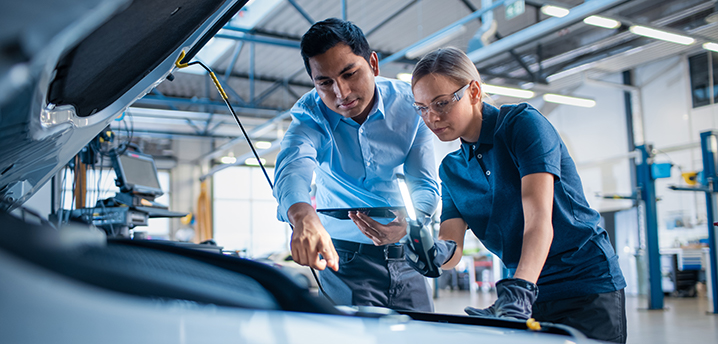At some point, your vehicle’s likely to break down. Don’t let car repair costs break your bank too.
There are a multitude of things that can go wrong when you own a car, from a fellow shopper swinging their car door into yours to create a gnarly dent or a pesky check engine light glowing a sickly amber on your dash.
Cars seemingly have a way of knowing when you’re strapped for cash, too. On a week when your rent’s due, you’ve lost three days’ pay to recover from the flu, and you just bought groceries, you could almost bet that you’ll hear a rrrng-ding-bang from somewhere in your car.
So what do you do when your car breaks down and you can’t afford to repair it, or repairing it means skimping on other bills? Fortunately, you can do some early planning so that a brake replacement (or other unexpected expenses) doesn’t break the bank.
How Much Do Car Repairs Cost?
A 2017 AAA survey found that the average auto repair cost is between $500 and $600. Such a cost isn’t insignificant; the same survey found that 64 million Americans would go into debt from that.
Maintenance is another significant factor in the cost of owning a car, and lack of maintenance can complicate — and increase the cost of — auto repairs. In other words, if you’ve neglected to properly maintain your car, the cost of repairing it could quickly exceed the average.
Types of car repairs
Not all auto repairs are equal. Buffing out a ding from the quarter panel differs from replacing the ignition in both cost and importance.
Naturally, body repairs are usually the least expensive and include:
| Type of Auto Body Repair |
Average Cost |
| Dented bumper |
$350 to $450 |
| Deep or extensive damage to paint |
$300 to $1,000 for a single-stage coat of paint; $1,000 to $3,500 to repair and paint over deeper or more extensive damage |
| Cracked windshield |
$110 for repair; $410 for replacement |
| Strut or shock absorber replacement |
$488 to $597 |
| Wheel alignment |
$115 to $302 |
| Ball joint replacement |
$225 to $285 |
| Rear-end damage |
Hundreds to potentially tens of thousands of dollars (depending on severity) |
A glowing check engine light can signal anything from a
minor issue to something more severe— and expensive. According to the
CarMD 2024 Vehicle Health Index, the 10 most common check engine repairs are:
| Type of Replacement |
Average Cost |
| Catalytic converter |
$1,375.70 |
| Oxygen sensor |
$245.88 |
| Ignition coil and spark plug |
$386.89 |
| Loose fuel cap tightening or replacement |
$25 |
| Mass air flow sensor |
$345.69 |
| Ignition coil |
$214.98 |
| Evaporative emissions purge control valve |
$144.07 |
| Fuel injector |
$457.63 |
| Evaporative emissions purge solenoid |
$150.85 |
| Thermostat |
$240.46 |
Other vehicle components are also prone to failure and can lead to a hefty repair or replacement cost.
Vehicle service contract data compiled by RateGenius showed the most frequent component failures in 2019 were:
| Type of Component Failure |
Average Claim Amount |
| Water pump |
$533 |
| A/C compressor |
$890 |
| Alternator |
$511 |
| Transmission/drivetrain |
$2,756 |
| A/C condenser |
$836 |
| Suspension control arm |
$747 |
| Radio |
$812 |
| Rack and pinion gear |
$1,245 |
| Engine — complete assembly |
$3,269 |
Repair costs
increase for luxury or sports cars, so you may be on the hook for repair costs that exceed the average.
Does Car Insurance Cover Auto Repairs?
Car insurance doesn’t cover the cost of maintenance or regular repairs, like a wheel alignment or water pump replacement. However, collision coverage does pay for repairs stemming from an accident, whether it involves just your vehicle or another vehicle or object.
As its name implies, comprehensive coverage protects against more than collisions, including damage from:
- Animals,
- Natural disasters and fire,
- Rioting and vandalism,
- Theft of all or part of the car,
- Falling objects, and
- Broken windshields.
If your car needs repairs following a covered event, great! Your insurer (or the insurance company that covers the driver who hit you) will pay for the cost of repairs, minus your policy’s deductible.
What car insurance won’t cover are all the other potential ways your car can go kaput.
9 Ways to Pay for Car Repairs
Planning for the eventuality of car repairs means you don’t have to rely on whether or not car insurance covers the cause.
Before getting overwhelmed by the potential of a large auto repair bill, consider the options available to you and your budget and figure out what methods work to pay for your car repairs.
1. Mechanical breakdown insurance
Mechanical breakdown insurance, or MBI, is a type of insurance that pays for the repairs to certain (you guessed it) mechanical breakdowns.
Essentially, MBI covers damage to your car resulting from incidents that wouldn’t be covered by your normal auto insurance. In other words, if you get into an accident, car insurance will pay for repairs, but if your engine lights up like the Fourth of July on your way to work, MBI would kick in to repair and replace it.
MBI covers:
- Electrical systems
- Oil pumps
- Timing gears
- Valves
- Brakes
- Transmissions
Mechanical breakdown insurance does not cover wear-and-tear or the cost of maintenance, though some policies may provide coverage for A/C, steering, or fuel systems.
Like car insurance, MBI policies typically have a deductible. However, MBI isn’t available for every car. An MBI policy can only be purchased for a new car or a car below a certain mileage (as defined by the specific policy).
2. Warranties
Different types of warranties are available depending on how you buy a car and if it’s new or used.
Factory or manufacturer’s warranties
Factory or manufacturer’s warranties are standard warranties included in the purchase of a new car. They’re generally comprised of multiple types of warranties that provide different coverages with the sole caveat that the covered incident must be the result of a factory defect.
In other words, if a part fails or breaks of its own accord (for example, by misuse, wear-and-tear, lack of maintenance, or as the result of an accident), a factory warranty won’t help you.
For example, a steering wheel issue caused by a software glitch or faulty power steering motor assembly could lead to a recall and repair covered under your factory warranty.
The different components of a factory warranty are in force for various lengths of time, depending on the type of coverage provided. For example, bumper-to-bumper coverage is often considered the most comprehensive aspect of a factory warranty but is likely the first warranty component to expire.
In some cases, you may be able to extend factory warranty coverage after it expires.
Dealer warranties
Warranties offered by dealers, particularly in the sale of a used car, include:
- Implied warranties: an unwritten promise that a used car’s basic functions work and the car runs.
- Limited warranties: a type of warranty that specifies certain aspects and components of the used car are covered and will be serviced by the dealer.
- Full warranties: guarantee free repair or replacement of covered components and systems within the warranty period (regardless of owner). If a repair is impossible to complete, the vehicle owner is entitled to a vehicle replacement or full refund.
Naturally, limited warranties are most commonly offered by used car dealers. However, dealerships may instead sell a car “as-is” to reduce or fully remove some or all implied warranties.
Extended warranties
Extended warranties are often referred to as “service contracts,” but the two products are not necessarily the same. Even more confusing is the incorrect interchangeability between extended warranties and MBI.
In the latter case, extended warranties are not an insurance product. Where insurance companies offer MBI, a wider swath of providers can offer extended warranties. Furthermore, extended warranties aren’t offered by just the manufacturer or dealer.
Third-party or standalone extended warranties provide varying types of coverage depending on the specific plan, but routine maintenance and wear-and-tear are usually not covered. In some cases, you may be able to purchase “wrap” coverage that would pay to repair anything other than the vehicle’s powertrain.
Some extended warranties provide additional protection and extras, such as roadside assistance, towing, and rental car reimbursement.
Because extended warranties can vary so wildly in coverage, carefully read over the policy before purchasing it to ensure it offers the protection you want and need.
3. Vehicle service contracts
Vehicle service contracts are optional plans sold by manufacturers, dealerships, and third-party providers. They can be purchased at the same time you buy a new or used car or later on, and are available for older cars or those with high mileage.
VSCs provide more comprehensive coverage than warranties. Typical VSCs provide coverage for mechanical issues, including relatively simple fixes — like air conditioning on the fritz — or more pressing (and expensive) problems, such as an engine replacement.
Vehicle service contracts do not cover cosmetic issues, routine maintenance, or wear-and-tear. Some VSCs also include a number of “exclusions” — specific parts or situations not covered by the plan in question.
Because these exclusions are so specific, you may be responsible for paying for a portion of a repair that’s otherwise covered if a certain part is excluded from coverage.
As a bonus, many VSCs provide extra coverage in the form of roadside assistance and towing and rental reimbursement.
4. Personal loans
Personal loans can serve as a means to pay for car repairs without leaving you broke. You can determine your eligibility for a personal loan at your preferred bank or credit union, and many even offer online applications. In many cases, personal loans are deposited into your bank account by the next business day. It’s worth noting that applying for a personal loan generally requires potential lenders to perform a credit check and review your credit history — so, if you have bad credit, this option may not be the best for you.
Friends and family can also offer you a personal loan, though be wary of just how personal it can get when borrowing from someone you know (and be sure not to take advantage of their kindness, either). Laying out the loan terms in writing may help relieve some stress for all parties involved.
Money borrowed through a personal loan can be used for any purpose and, subsequently, any sort of car repair. So long as you borrow enough to cover the mechanic’s bill, you’re clear and golden.
The only requirement is that you pay back the loan — both the principal and any accumulated interest — as agreed. However, because personal loans are installment loans, the amount you’ve borrowed is broken up into much more affordable monthly payments compared to the full and upfront cost of paying for repairs with your savings.
5. Auto repair loans or payment plans
Some mechanics and auto repair shops offer car repair loans or other types of financing options.
Larger mechanics, like chains, may offer an auto repair loan, auto repair financing, or payment plan themselves. With a payment plan, you’re responsible for making installment payments directly to the shop. Other mechanics, especially smaller auto shops, work with a network of lenders to offer loans to customers.
Once your loan has been approved, the lender may pay the repair shop itself or issue you a credit card to pay the mechanic yourself.
Regardless of which loan option you choose for financial assistance, the money you borrow or use must go toward:
- Repairs and service,
- Maintenance,
- Tires, and/or
- Your insurance deductible.
Funds typically can’t be used to pay for your extended warranty or any prepaid services. Non-essential parts, installations, and repairs aren’t typically covered either.
6. Credit cards
16% of Americans would use a credit card for an emergency, such as an unexpected auto repair. Maintaining an emergency credit card isn’t a bad idea, though it’s not always the best idea to rely on it as your first choice.
Still, sometimes the stars just don’t align. If your car’s out of warranty and not otherwise covered, you don’t have enough savings to cover a repair, and you can’t or don’t want to apply for a loan, a credit card can make the difference between you getting to work or not.
By paying with a credit card, you’re not restricted from what services or components you can have repaired or replaced. Instead, you’re limited by the available credit you have on your card. If the cost of repairs exceeds what you can charge to your card, you may have to make up the difference through another method.
7. DIY
A wealth of resources are available to guide you through performing some less complex repairs yourself.
By taking the DIY route, you could feasibly save hundreds — or even thousands — in exchange for a little effort, the cost of parts, and maybe a case of beer or two for a friend. Even better, if you really know what you’re doing, you could have it fixed the same day it breaks! Most garages can’t even promise that.
If you’re not mechanically-inclined or just not interested, consider buying used parts online or from a local auto shop or junkyard, then having them professionally installed at the mechanic of your choice. This path will be more expensive than doing it all yourself, but you’ll also be saving money by not paying for new replacement parts.
8. Contribute to a dedicated savings account
One of the easiest ways of avoiding the stressors of an unexpected car repair is to save for repair costs beforehand. Strive to sock away money — or auto refinance savings — into an emergency fund for the inevitable trip to a mechanic.
Your savings can be used for repairs of any nature, and many banks and credit unions offer options to automatically deposit a portion of each paycheck into a savings account. Over time, these relatively small deposits add up and can eventually go toward car repairs or maintenance.
9. Sell your car
Sometimes repairing a car just isn’t worth it to you but is a quick fix to someone else willing to take the car off your hands. As a result, you could sell your broken car for cash to be used as a down payment for a new car or to purchase a used car outright.
If your car’s not in sellable condition or you’re just sick of trying to get rid of it, you could also try parting it out for cash. DIYers and local mechanics can use the functioning components to repair a car in better condition or Frankenstein one back to life, and you can use the cash to get back on the road again.
What Car Repair Payment Methods Should I Avoid?
Some methods of paying for auto repairs can get you back on the road, but can cost you far more in the long run. Steering clear of ill-advised payment options and unscrupulous lenders can save you from a bigger headache than figuring out how you’ll pay to fix your car through one of the methods above.
Title loans
A car title loan is a short-term loan in which you sign your car title over to a title company, which, in turn, uses your car as collateral. You are then loaned a percentage of your car’s value that can be used for auto repairs or other purposes.
Title loans do not impact or take into consideration your credit score, but usually require full repayment — including interest — within 15 to 30 days.
According to the Consumer Financial Protection Bureau, the typical APR of a title loan is 300%, which makes this form of financing incredibly expensive. In addition, borrowers must usually pay fees for taking out a title loan.
The CFPB has found that four out of five borrowers fail to pay off a title loan in a single payment, prompting them to roll over the loan from month to month and incurring higher interest charges and fees.
Because your car is used as collateral, defaulting on a title loan means the lender will seize or repossess the vehicle. One out of every five borrowers lose their vehicles to a title loan company for failure to pay, according to CFPB research.
Payday loans
Payday loans are also called cash or check advance loans and represent another type of short-term financing with an extremely high interest rate. Payday loans are based on a combination of your income and credit. The average payday loan amount is about $500 with an APR of 400%, along with other fees.
Repayment of a payday loan, including interest, is typically due upon your next payday, hence the name. If you fail to pay back the loan on time, the lender continually rolls it into a new term while adding additional fees and penalties, on top of accumulating interest.
Payday loans narrowly beat title loans because they’re unsecured — the lender has no collateral to repossess. Still, because of fees and exceptionally high interest rates, they can be hard to pay off in time and should be avoided to the best of your ability.
Do GAP Waivers Pay for Car Repairs?
GAP coverage, or guaranteed asset protection, is sold in the form of a waiver or insurance policy and helps cover the gaps between what you owe on your car loan and what your auto insurance pays out for a covered incident.
But how does GAP help in the case of car repairs?
Short answer: It doesn’t. GAP only covers events in which your car is a total loss. Even if you intend on tying some scrap together and pedaling your totaled car like Fred Flintstone, GAP isn’t a product that will help you with any mechanical breakdowns or malfunctions.
Can I Negotiate the Cost of Vehicle Repairs?
Whether you’re paying with your own cash or through a loan, the less repairs cost, the less you spend overall. As with most interpersonal situations in life, communication is key.
First, be prepared to shop around. Unless you need to have your car repaired at a specific authorized repair facility to satisfy the requirements of a warranty or other policy, take one shop’s estimate to a competitor to see if you can get a better deal.
Bear in mind that shops aren’t typically able to reduce their labor cost or fixed-price services. However, as with DIY repairs, you can opt to use non-OEM, or non-manufacturer, parts to reduce repair costs. Some “broken” components don’t need to be replaced right away, either.
Try explaining your financial situation to your mechanic, as well. If you’ve done your research to find a reputable and trustworthy shop, your mechanic might be more willing to work with you on cost or ways to make your vehicle at least roadworthy, if fixing it entirely is out of your budget.
How to Avoid Costly and Unexpected Car Repairs
Ultimately, the key to avoiding costly car repairs is to maintain your vehicle. Though there’s no guarantee something won’t go wrong, proper maintenance can nip a lot of problems in the bud before they become expensive — or prevent the issue entirely.
By staying up-to-date on replacing fluids, checking your oil, keeping it clean, and otherwise taking care of your vehicle, you can stave off the worst of overwhelming car repair bills.
Sure, there’s some cost involved in maintaining your car, but it’s also an investment in your vehicle’s longevity, your long-term finances, and your stress levels.
If all else fails, planning ahead and knowing how to pay for car repairs can reduce your stress and out-of-pocket expenses if and when your car breaks down — and keep you away from predatory practices like title and payday loans.
About The Author
Robert Janssen
Robert Janssen is the Vice President of Operations for Tresl, and has been working in the auto finance industry for 15 years. He recieved a B.A. in Economics from the University of Texas at Austin.
;)





